Introduction:
Step back in time to an era when monstrous creatures ruled the Earth and the natural world was a realm of primal terror. Join us as we delve into the depths of prehistory to uncover the most spine-chilling inhabitants of ancient ecosystems. From colossal predators that prowled the land to nightmarish sea monsters lurking in primordial seas, the stories of these 11 terrifying prehistoric animals will ignite your imagination and send shivers down your spine. Brace yourself for an unforgettable journey into the darkest corners of Earth’s distant past.
11. Dunkleosteus
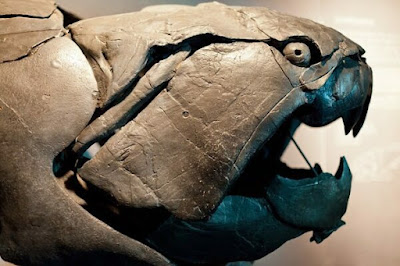
Dunkleosteus is an extinct genus of arthrodire placoderm fish that lived during the Late Devonian period, around 358 to 382 million years ago. It belonged to a group of heavily armored fish that dominated the seas during this time. The name Dunkleosteus honors David Dunkle, a former curator at the Cleveland Museum of Natural History, who studied Devonian fish.
These creatures were formidable predators, with massive jaws and sharp, bony plates serving as teeth, capable of delivering a powerful bite force. They could grow to impressive sizes, with some species reaching lengths of up to 33 feet (10 meters) and weights of several tons. Despite their size and fearsome appearance, Dunkleosteus likely primarily fed on smaller fish and other aquatic organisms.
Dunkleosteus had a streamlined body with powerful fins, enabling it to swiftly navigate through the waters in pursuit of prey. Its heavily armored head provided protection against potential predators and rival Dunkleosteus individuals during territorial disputes.
Fossils of Dunkleosteus have been found in various locations around the world, including North America, Europe, and Africa. These fossils have provided valuable insights into the anatomy, behavior, and ecology of these ancient marine predators, contributing to our understanding of Devonian ecosystems and the evolution of vertebrates.
10. Helicoprion
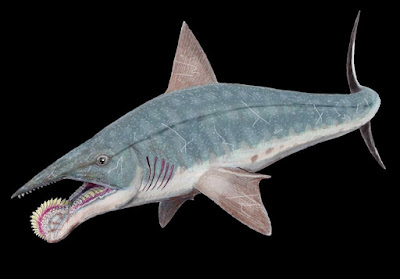
Helicoprion is an extinct genus of shark-like fish that lived during the Permian and early Triassic periods, approximately 290 to 250 million years ago. It is known for its unique spiral-shaped tooth whorl, which is one of the most distinctive features in the fossil record.
The most famous aspect of Helicoprion is its bizarre tooth structure. Instead of individual teeth, Helicoprion possessed a single, continuously growing spiral-shaped tooth whorl, which was housed in its lower jaw. As the older teeth wore down, new teeth would grow from the center of the spiral and gradually push older teeth outward in a continuous helical pattern. This tooth arrangement is unlike anything seen in modern sharks or any other vertebrates.
The exact placement and function of the tooth whorl within the mouth of Helicoprion have been the subject of debate among scientists. Some researchers propose that the tooth whorl was located at the front of the lower jaw, resembling a circular saw blade. Others suggest that it was positioned deeper within the jaw, functioning more like a crushing or grinding surface.
Despite its unique dental structure, much about the biology and behavior of Helicoprion remains speculative due to the limited fossil evidence available. Fossils of Helicoprion have been found in various parts of the world, including North America, Europe, and Asia.
While Helicoprion is often depicted in popular media with its tooth whorl protruding from its mouth in a menacing fashion, its appearance and lifestyle remain a subject of scientific inquiry and speculation. Nevertheless, its unusual dental adaptation has made it a fascinating subject of study in the field of paleontology.
09. Arthropleura
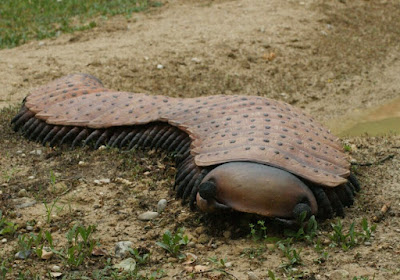
Arthropleura was an extinct genus of giant arthropods that lived during the Carboniferous period, around 345 to 290 million years ago. These creatures were among the largest land invertebrates to have ever lived, with some species reaching lengths of over 6.5 feet (2 meters) and widths of up to 1.6 feet (0.5 meters). Arthropleura belonged to the group of arthropods known as millipedes, specifically the class Diplopoda.
Arthropleura had a long, segmented body covered in a hard exoskeleton, which provided protection and support. Its body was composed of numerous jointed segments, giving it flexibility and allowing it to move across the forest floor with ease. Despite their large size, Arthropleura were likely herbivores, feeding on decaying plant matter, leaves, and other organic material.
Fossils of Arthropleura have been found in various locations around the world, including North America and Europe. The abundance of fossils suggests that Arthropleura was once widespread and relatively common in the humid, forested environments of the Carboniferous period.
The exact reason for the extinction of Arthropleura and other large arthropods from the Carboniferous period remains uncertain. However, it is thought that changes in climate, habitat, and competition with other organisms may have played a role in their decline.
Despite their extinction, Arthropleura remains a fascinating subject of study for paleontologists, providing valuable insights into the diversity and evolution of ancient terrestrial ecosystems during the Carboniferous period.
08. Smilodon

Smilodon, commonly known as the saber-toothed cat or saber-toothed tiger, is an extinct genus of large predatory mammal that lived during the Pleistocene epoch, approximately 2.5 million to 10,000 years ago. Smilodon is famous for its long, curved canine teeth, which could grow up to 11 inches (28 centimeters) in length, and for its robust build, making it one of the most iconic prehistoric predators.
Smilodon belonged to the family Felidae, which includes modern-day cats, and it is estimated to have weighed between 200 to 600 kilograms (440 to 1,320 pounds), depending on the species. Its large size, powerful jaw muscles, and specialized teeth suggest that Smilodon was a formidable predator, capable of taking down large prey.
Despite its common name, Smilodon was not closely related to modern-day tigers. Instead, it belonged to a separate evolutionary lineage known as the machairodonts, which diverged from the lineage that led to modern cats millions of years ago.
Fossils of Smilodon have been discovered in various parts of North and South America, with some of the most well-preserved specimens found in the La Brea Tar Pits in Los Angeles, California. These fossils have provided valuable information about the anatomy, behavior, and ecology of Smilodon, shedding light on its hunting strategies, social behavior, and interactions with other Pleistocene fauna.
The extinction of Smilodon and other large mammals during the late Pleistocene is a subject of ongoing scientific debate. Climate change, human hunting, and shifts in habitat and prey availability have all been proposed as potential factors contributing to their demise.
Despite its extinction, Smilodon continues to capture the imagination of scientists and the public alike, with its distinctive appearance and role as one of the apex predators of the Pleistocene era.
07. Livyatan melvillei
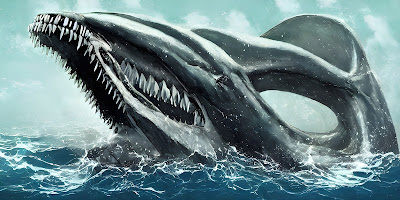
Livyatan melvillei is an extinct species of prehistoric whale that lived during the Miocene epoch, approximately 12 to 13 million years ago. It is named after the biblical sea monster Leviathan and the author Herman Melville, who wrote the novel “Moby-Dick.” Livyatan melvillei is believed to have been one of the largest predatory whales to have ever existed, with estimates suggesting it reached lengths of up to 13.5 to 17.5 meters (44 to 57 feet).
One of the most striking features of Livyatan melvillei is its massive skull, which measures over 3 meters (10 feet) in length and contains large, robust teeth. These teeth are similar in shape and size to those of the modern sperm whale, but significantly more robust, suggesting that Livyatan melvillei was a formidable predator capable of hunting large prey.
Fossils of Livyatan melvillei have been found in various locations around the world, including Peru and the Atacama Desert in Chile. These fossils have provided valuable insights into the anatomy, behavior, and evolutionary history of this ancient whale species.
Livyatan melvillei likely inhabited the oceans as a top predator, preying on large marine animals such as seals, dolphins, and other whales. Its size and hunting prowess would have made it a dominant force in the marine ecosystems of the Miocene epoch.
Despite its impressive size and fearsome appearance, Livyatan melvillei eventually became extinct, with the exact reasons for its demise remaining uncertain. Changes in climate, habitat, and competition with other marine predators may have all played a role in its extinction.
The discovery and study of Livyatan melvillei have provided valuable insights into the diversity and evolution of ancient whales, as well as the dynamics of prehistoric marine ecosystems.
06. Spinosaurus

Spinosaurus is an extinct genus of large predatory dinosaur that lived during the Cretaceous period, approximately 112 to 93 million years ago. It is one of the most iconic and fascinating dinosaurs, known for its distinctive sail-like structure on its back and its elongated jaws filled with conical teeth. Spinosaurus belongs to the group of theropod dinosaurs, which also includes famous carnivores like Tyrannosaurus rex and Velociraptor.
The most distinguishing feature of Spinosaurus is the sail-like structure formed by elongated neural spines extending from its vertebrae. The exact function of this sail remains a subject of scientific debate, with hypotheses ranging from thermoregulation to display or even aiding in swimming.
Spinosaurus was an incredibly large dinosaur, with some estimates suggesting it reached lengths of up to 50 to 60 feet (15 to 18 meters) and weighed as much as 7 to 20 tons. Its long and slender skull, filled with sharp teeth, indicates that it was well-adapted for hunting fish and other aquatic prey.
Fossils of Spinosaurus have been discovered in various parts of North Africa, particularly in modern-day Morocco and Egypt. These fossils have provided valuable insights into the anatomy, behavior, and ecology of this ancient dinosaur.
Recent discoveries and research have suggested that Spinosaurus was likely a semi-aquatic dinosaur, spending much of its time in water and hunting for fish and other aquatic prey. Its adaptations, including its elongated snout and conical teeth, support this hypothesis.
Spinosaurus has captured the public’s imagination and has been prominently featured in popular culture, including movies, documentaries, and books. Its unique appearance and speculated lifestyle continue to intrigue scientists and dinosaur enthusiasts alike, making it one of the most fascinating dinosaurs to have ever roamed the Earth.
05. Sarcosuchus

Sarcosuchus, commonly known as the “SuperCroc,” is an extinct genus of giant crocodile-like reptile that lived during the Early Cretaceous period, approximately 112 to 97 million years ago. It is one of the largest crocodyliforms ever to have existed, with some estimates suggesting it reached lengths of up to 11 to 12 meters (36 to 39 feet) and weighed as much as 8 to 10 tons.
Sarcosuchus had a long, broad skull filled with numerous sharp teeth, indicating that it was a formidable predator. Its powerful jaws and immense size would have allowed it to hunt a wide range of prey, including fish, turtles, and even large dinosaurs that ventured too close to the water’s edge.
Fossils of Sarcosuchus have been discovered in various parts of North Africa, particularly in modern-day Niger and Morocco. These fossils have provided valuable insights into the anatomy, behavior, and ecology of this ancient reptile.
Despite its superficial resemblance to modern crocodiles, Sarcosuchus belonged to a separate evolutionary lineage known as the pholidosaurids. Unlike modern crocodiles, which are semi-aquatic, Sarcosuchus was likely a fully aquatic predator, spending most of its time in rivers and lakes.
Sarcosuchus has been a subject of fascination for scientists and the public alike due to its immense size and fearsome appearance. Its discovery has also shed light on the diversity of crocodile-like reptiles that inhabited the Earth during the Mesozoic era.
04. Titanoboa
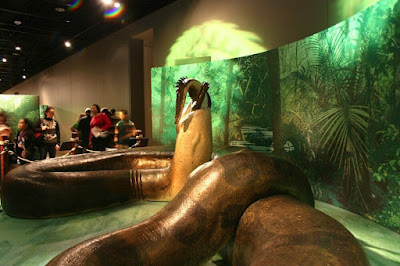
Titanoboa is an extinct genus of giant snake that lived during the Paleocene epoch, approximately 58 to 60 million years ago. It is considered one of the largest snakes to have ever existed, with estimates suggesting it reached lengths of up to 12 to 15 meters (about 39 to 49 feet) and weighed as much as 1,135 to 2,200 kilograms (about 2,500 to 4,850 pounds).
The name “Titanoboa” translates to “titanic boa,” reflecting its enormous size and its classification within the family Boidae, which includes modern boas and anacondas. Titanoboa likely inhabited the lush, swampy forests of South America, where it would have preyed upon a variety of animals, including large fish, turtles, and possibly even small crocodiles.
Fossils of Titanoboa were first discovered in the Cerrejón Formation of Colombia in 2009. These fossils provided valuable insights into the anatomy, behavior, and ecology of this ancient serpent. Based on its size and body proportions, scientists believe that Titanoboa was a powerful constrictor, capable of overpowering prey much larger than itself.
The discovery of Titanoboa has contributed to our understanding of the diversity and evolution of snakes, as well as the paleoclimate and ecosystems of the Paleocene period. Its immense size and role as a top predator in its ancient environment have made it a subject of fascination for scientists and the public alike.
03. Giganotosaurus
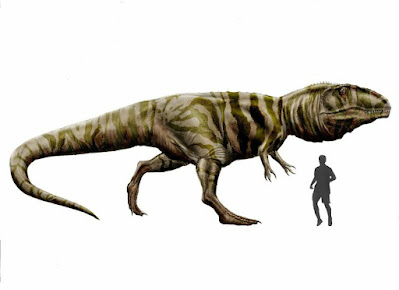
Giganotosaurus is an extinct genus of large theropod dinosaur that lived during the Late Cretaceous period, approximately 98 to 97 million years ago. It is one of the largest known carnivorous dinosaurs, rivaled only by species like Tyrannosaurus rex and Spinosaurus.
The name “Giganotosaurus” translates to “giant southern lizard,” reflecting its immense size and the fact that its fossils were first discovered in southern Argentina. Giganotosaurus is classified as a carcharodontosaurid, a group of theropod dinosaurs characterized by their large size and serrated teeth.
Giganotosaurus is estimated to have reached lengths of up to 12 to 13 meters (about 39 to 43 feet) and weighed as much as 6 to 13 tons, making it slightly larger than Tyrannosaurus rex. It had a long, slender skull filled with sharp, serrated teeth, which would have been used to tear flesh from its prey.
Fossils of Giganotosaurus have been found in various locations in South America, particularly in Argentina, Brazil, and Uruguay. These fossils have provided valuable insights into the anatomy, behavior, and ecology of this ancient predator.
Based on its size and features, scientists believe that Giganotosaurus was an apex predator, capable of hunting and bringing down large herbivorous dinosaurs like sauropods. Its discovery has contributed to our understanding of the diversity and evolution of theropod dinosaurs during the Late Cretaceous period.
02. Megalodon

Megalodon, meaning “giant tooth,” is an extinct species of shark that lived during the Cenozoic era, approximately 23 to 3.6 million years ago. It is one of the largest and most powerful predators to have ever existed in the oceans, with estimates suggesting it reached lengths of up to 18 meters (59 feet) or even more. Megalodon belonged to the family Otodontidae, which includes other extinct giant sharks.
The most distinctive feature of Megalodon is its massive, triangular teeth, which could grow up to 7 inches (18 centimeters) in length. These teeth are among the largest of any known shark species and are highly prized by fossil collectors.
Megalodon likely inhabited oceans worldwide, with fossils found in various locations across the globe, including North and South America, Europe, Africa, Asia, and Australia. It is believed to have been a top predator in its marine ecosystem, preying on a wide range of marine mammals, including whales, dolphins, seals, and other large fish.
Despite its impressive size and formidable hunting abilities, Megalodon became extinct around 3.6 million years ago, at the end of the Pliocene epoch. The exact reasons for its extinction remain uncertain, but factors such as changes in ocean temperature, shifts in prey availability, and increased competition from other predators may have played a role.
Megalodon continues to capture the public’s imagination and has been featured in numerous books, documentaries, and movies. Its immense size, powerful jaws, and mysterious disappearance make it one of the most iconic and intriguing creatures in the history of the natural world.
01. Jaekelopterus
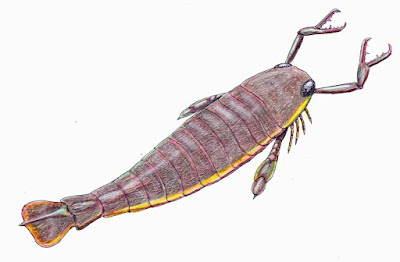
Jaekelopterus is an extinct genus of giant aquatic arthropod, specifically a eurypterid or “sea scorpion,” that lived during the Silurian period, approximately 390 to 380 million years ago. It is one of the largest arthropods ever to have existed, with some species reaching lengths of up to 2.5 meters (8.2 feet).
The name “Jaekelopterus” honors Otto Jaekel, a German paleontologist known for his contributions to the study of ancient arthropods. Jaekelopterus had a long, segmented body with powerful swimming appendages and a pair of large pincers at the front, which it likely used to grasp and subdue prey.
Fossils of Jaekelopterus have been discovered in various locations around the world, including Europe, North America, and South America. These fossils have provided valuable insights into the anatomy, behavior, and ecology of this ancient marine predator.
Jaekelopterus was a carnivorous predator, feeding on a variety of small marine organisms, including fish, crustaceans, and other arthropods. Its large size and formidable appearance would have made it a dominant predator in the ancient oceans of the Silurian period.
Despite its impressive size and predatory adaptations, Jaekelopterus eventually became extinct, likely due to changes in environmental conditions or competition with other marine predators. However, its fossils serve as a reminder of the incredible diversity and evolution of ancient arthropods during the Paleozoic era.